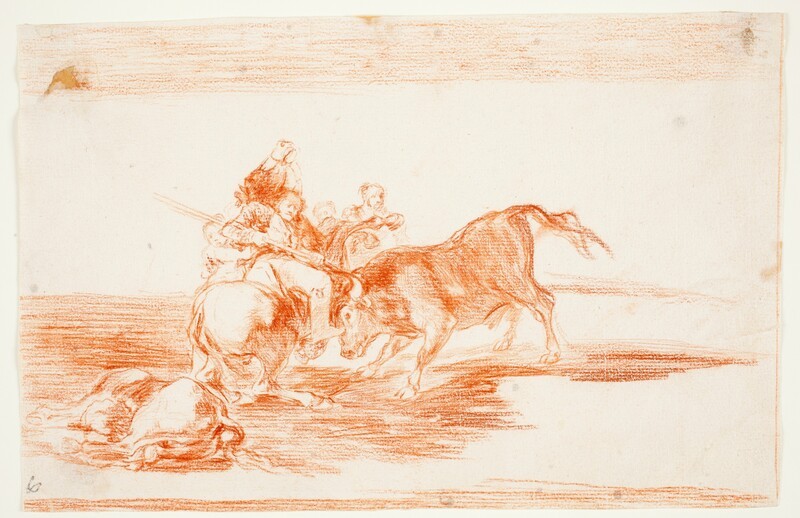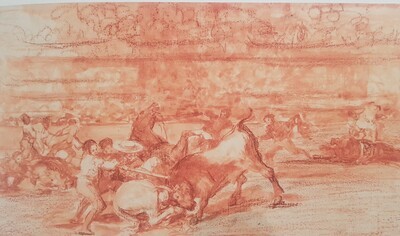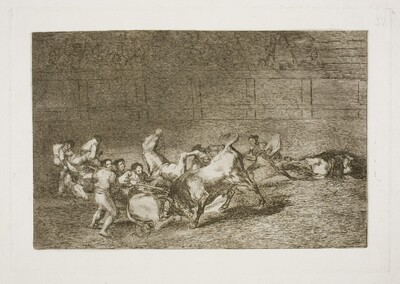- Cronología
- Ca. 1814 - 1816
- Ubicación
- The Prado National Museum. Madrid, Madrid, Spain
- Dimensiones
- 191 x 294 mm
- Técnica y soporte
- Reconocimiento de la autoría de Goya
- Documented work
- Titular
- El Prado National Museum
- Ficha: realización/revisión
- 03 Oct 2021 / 22 Jun 2023
- Inventario
- (D4317)
- Otros títulos:
-
6 (in pencil, lower left-hand corner)
See How the ancient Spaniards hunted bulls on horseback in the countryside.
This preparatory drawing passed by inheritance in 1828 to Javier Goya, the painter's son, and in 1854 to Mariano Goya y Goicoechea, the artist's grandson. It was subsequently owned by Valentín Carderera (ca. 1861) and Mariano Carderera (1880). In 1886 it was acquired from Mariano Carderera, along with many other drawings by Goya, including almost all the preparatory studies for the Bullfight, by the Directorate General of Public Instruction, and was assigned to the Prado Museum, where it entered on 12 November 1886.
See How the ancient Spaniards hunted bulls on horseback in the countryside.
First of the two preparatory drawings for the print Two groups of bullfighters being run over at once by a single bull. The present preparatory study, which focuses exclusively on the central group of the future print, is characterised by its great precision and detail. In it we see the bull charging a horse with the picador on top of it, who is thrusting his pike into the bull's neck. Between the two contenders, contrasting in their posture and lighting - the horse receives more light than the bull - a fierce fight is taking place. Behind the two fighting animals we can see a series of figures, probably labourers, who are trying to separate the bull from the horse, as the bull has a piton stuck in the equine's belly. In the corner on the left, in the foreground, another picador's horse is lying on the ground with its guts spilled after a previous attack by the bull. In the background, the barrier is indicated in summary form, unlike what Goya would do in the second preparatory drawing and in the definitive engraving.
On the back of the sheet there is a slight hint of a horse in sanguine and traces of sanguine in contact with other drawings.
-
cat. 193-195
-
Goya. Das Zeitalter der Revolucionen. Kunst um 1800 (1980 – 1981)Hamburger KunsthalleHamburg1980
-
Goya: toros y torerosEspace Van GoghArles1990displayed also at Academia de Bellas Artes de San Fernando, Madrid, consultant editor Pierre Gassier.cat. 36-37
-
Goya en tiempos de guerraMuseo Nacional del PradoMadrid2008consultant editor Manuela B. Mena Marqués, from April 14th to July 13th 2008cat. 157
-
1946pp. 177-216, espec. pp. 206-207
-
MadridMuseo del Prado1954cat. 183
-
1961pp. 120-127
-
ParísLe Club Français du Livre1963p.138
-
Vie et ouvre de Francisco de GoyaParísOffice du livre1970p. 280, cat. 1216
-
Barcelona1974p. 17
-
The Changing image: Prints by Francisco GoyaBostonMuseum of Fine Arts1974pp. 241-243, cat. 193-195
-
Dibujos de Goya, 2 volsBarcelonaNoguer1975pp. 400-401, cat. 275
-
MadridMuseo Nacional del Prado2001pp. 95-97
-
MadridMuseo Nacional del Prado y Ediciones El Viso2008pp. 437-439, cat. 157-158


